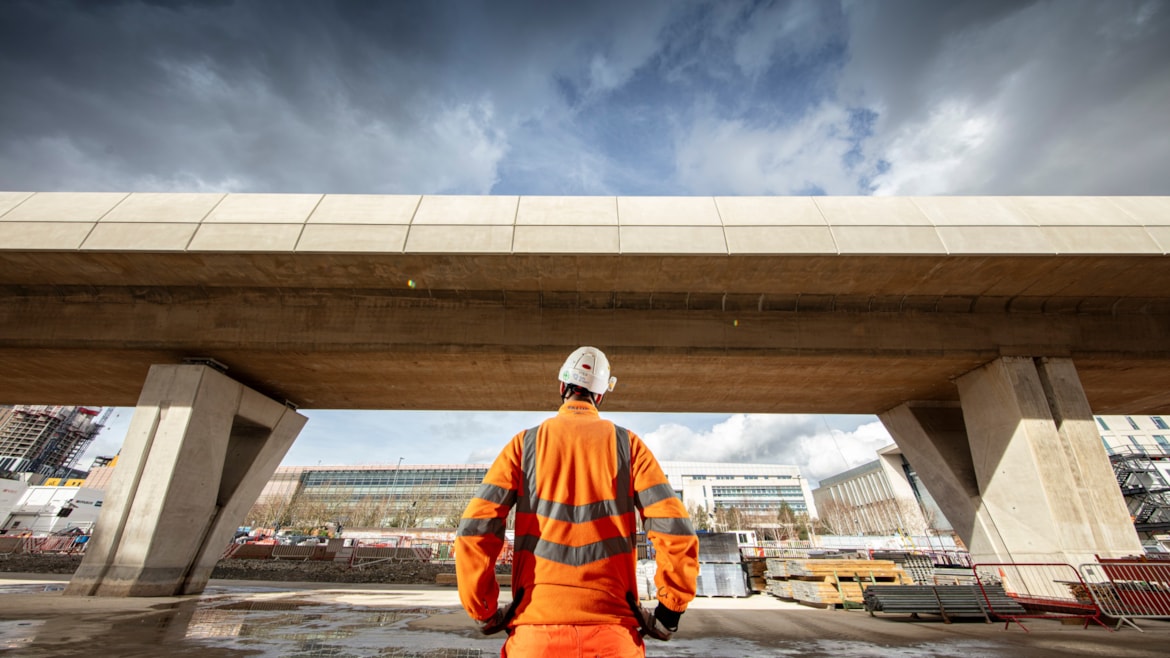HS2 has released new images of the first completed sections of the landmark viaduct that will bring high speed trains into Birmingham’s new Curzon Street station.
The completed sections mark the next step on the programme to build a series of viaducts to carry the railway through Birmingham’s industrial heartland and into the city centre.
High speed trains will travel out of the west portal of the 3.5 mile Bromford Tunnel at Washwood Heath and onto a one mile long stretch of connected viaducts through Duddeston, and cross over the Birmingham to Derby railway, Lawley Middleway and Digbeth Canal.
On the approach into Birmingham, the five viaducts are Duddeston, Curzon 1, Curzon 2, Lawley Middleway and Curzon 3 – which links to Curzon Street station.
The completed six metre-high sections of the Curzon 3 viaduct are where the structures widen from a single deck to four separate decks, spanning 65 metres at the widest point, to carry the tracks to the Curzon Street station platforms.
The viaducts are being built by HS2’s Midlands contractor Balfour Beatty VINCI, with a team of more than 200 people including specially trained joiners, steel fixers and scaffolders from the local area, including five apprentices.
Since the concrete pour for the first Curzon 3 viaduct decks started in November last year, the site team have completed all the deck work, attached the parapets and removed the shuttering and scaffolding to reveal the finished Curzon 3 deck concrete sections.
3,700 cubic metres of concrete have been poured to make the four individual sections of the Curzon 3 viaduct, that will connect to the future station platforms. 88 concrete parapets have been installed so far, creating the side barriers of the viaduct. A total of 176 parapets are needed for the entire Curzon 3 structure, each measuring between 1.6m and 2.9m high, and weighing between four and five tonnes each.
When complete, HS2 will improve connections between London and the West Midlands, with trains running further north on existing lines. This new high speed railway will create quicker and far more reliable journeys, driving economic growth while crucially freeing up space for more local trains on the most congested part of the existing West Coast Main Line.
Stephen Powell, HS2’s Head of Delivery said:
“It’s fantastic to see the first sections of this viaduct revealed, giving a clear view of how HS2 trains will approach Birmingham city centre. Now visible, you can see how the separate deck sections maximise daylight underneath, and the V-shaped piers take up less room at ground level, providing opportunities for a usable public space that will add to the life of the city.”
Georgios Markakis, Section Manager at Balfour Beatty VINCI said:
“We’re entering a really exciting phase of the project now, as this iconic viaduct in the centre of Birmingham begins to take shape. These images revealed by HS2 demonstrate the enormous progress we’re making at our Curzon Street site.
“Using this momentum, we’re currently installing four parapets each day, while following the same process to complete the remaining deck spans, which we expect to finish in 2026.”
The viaducts are designed by a Design Joint Venture of Mott MacDonald and SYSTRA with architects Weston Williamson + Partners, all working for Balfour Beatty VINCI.
Nicholas Robertshaw, Design Project Director at Mott MacDonald SYSTRA Design Joint Venture said:
“With the first sections of the Curzon 3 viaduct now complete it’s clear to see that this will be a landmark structure that everyone in Birmingham can celebrate and be proud of.
“From an engineering perspective Curzon 3 viaduct is a remarkably complex structure. With thanks to the hard work of the Design Joint Venue, this has only been made possible through extensive technical analysis and engineering excellence – the result of many years of innovative design development.”
Further sections of the Curzon 3 viaduct will be built in the same way, and later this year, the construction of the span over Digbeth Canal will commence using jacks to slide 34 temporary steel girders, each measuring 38 metres long, below the four steel tripods to support the falsework and formwork, necessary for the deck construction.
The large arched span over Lawley Middleway is made from weathering steel girders, and is currently being built on the site. It will be moved into place over the road during a series of short night-time road closures in the summer. Building it in this way drastically cuts disruption to road users.

